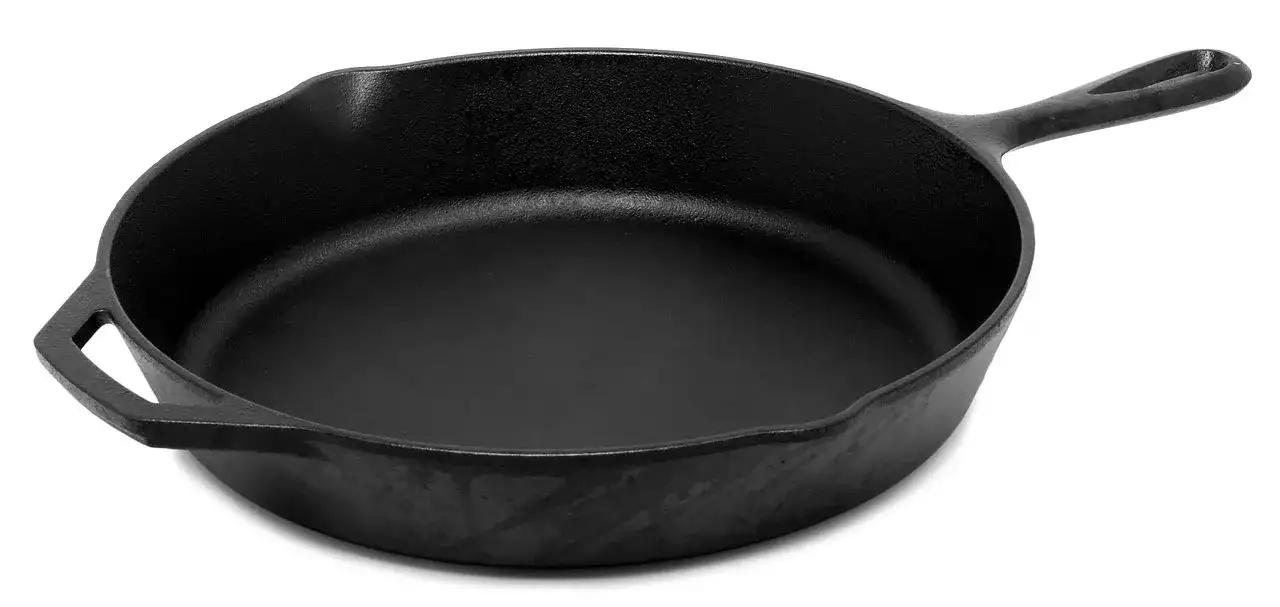Ductile iron (or nodular cast iron) features spheroidal graphite nodules and offers superior tensile strength and ductility compared to traditional grey cast iron, yet most cookware today remains made from grey cast iron due to its proven seasoning performance and cost-effectiveness. While ductile iron cookware is commercially available—often via specialty OEM channels in China—it remains uncommon in Western markets, as its higher material and processing costs outweigh marginal benefits in toughness or wall-thickness reduction. From a safety standpoint, both ductile and grey cast irons are FDA-approved for food contact, with seasoned surfaces providing natural nonstick properties and minimal iron leaching—an essential dietary mineral—when properly maintained.

1. Cast Iron Types in Cookware
1.1 Grey Cast Iron
Grey cast iron, the longstanding material for skillets and Dutch ovens, contains 2.5–4 % carbon and 1–3 % silicon, forming flaky graphite structures that facilitate seasoning adhesion and stable nonstick surfaces. Its high heat capacity (thermal conductivity ≈ 60 W/m·K) and robust damping make it ideal for even heat distribution, despite being brittle under impact.
1.2 Ductile (Nodular) Iron
Ductile iron, alloyed with magnesium to create nodular graphite, exhibits 415–550 MPa tensile strength and up to 18 % elongation, dramatically reducing cracking risk under mechanical shock. Its thermal conductivity (≈ 36 W/m·K) remains adequate for cooking, but the denser microstructure can impede seasoning absorption compared to grey iron.
2. Manufacturing Considerations
2.1 Material Sourcing & Casting
Leading cookware brands (e.g., Lodge) carefully control their melt stock—pig iron, steel slitter, and returns—to achieve consistent grey iron chemistry, a process less established for ductile grades in cookware foundries. Alibaba-listed OEMs offer “ductile cast iron cookware,” but these often target bulk buyers and may lack the heritage seasoning and finish of established grey-iron makers.
2.2 Surface Finish & Seasoning
Grey iron’s micro-roughness accepts oil-based seasoning more readily, forming a polymerized patina that imparts nonstick behavior; ductile iron’s finer grain may require additional surface texturing to match this performance.
3. Pros & Cons Comparison
| Feature | Grey Cast Iron | Ductile (Nodular) Iron |
|---|---|---|
| Tensile Strength | 100–450 MPa | 415–550 MPa |
| Ductility | < 1 % elongation | Up to 18 % elongation |
| Thermal Conductivity | ≈ 60 W/m·K | ≈ 36 W/m·K |
| Seasoning Retention | Excellent (flake graphite) | Good, but may need texturing |
| Cost & Availability | Low–moderate; ubiquitous brands | Higher; niche OEM supply |
| Weight & Handling | Heavier walls; stable heat | Can achieve thinner sections; slightly lighter |
4. Safety & Food-Contact Compliance
-
FDA Approval: Both grey and ductile irons are FDA-compliant for food contact when manufactured and seasoned per guidelines.
-
Iron Leaching: Properly seasoned cast-iron pans release minimal iron—beneficial for many diets—with no evidence of toxicity from typical culinary use.
-
Maintenance: Avoid harsh detergents or acidic soak; re-season regularly to maintain a protective, polymerized oil layer that prevents rust and flavor transfer.
5. Market Availability
While mainstream brands (Lodge, Le Creuset, Field Company) exclusively use grey cast iron, select Chinese OEMs list “ductile cast iron” cookware on platforms like Alibaba, offering skillets, Dutch ovens, and teapots in bulk lots. However, few Western retailers stock these, citing consumer preference for the traditional seasoning performance of grey iron.
6. FAQ
Q1: Can ductile iron be used to make cookware?
Yes—ductile iron can be cast into skillets, Dutch ovens, and more, but it is uncommon outside OEM channels due to cost and seasoning considerations.
Q2: Is ductile iron cookware better than traditional cast iron?
Ductile iron offers higher toughness and thinner walls, but grey cast iron excels in seasoning retention and even heating, making it the preferred choice for most cooks.
Q3: How do I clean and season ductile iron cookware?
Treat it like grey cast iron: scrub with minimal soap, dry immediately, then apply a thin layer of oil and heat to polymerize a protective patina.
Q4: Are there health concerns with ductile iron cookware?
No—both ductile and grey cast irons are FDA-approved for food use; iron leaching is minimal and generally beneficial in moderation.
Q5: Where can I buy ductile iron cookware?
Primarily through specialty OEM suppliers like us(LuoKaiWei); Western stores typically stock only grey cast iron from brands like Lodge and Le Creuset.
References:
- Ductile Iron – Wikipedia: Overview of Composition, Properties, and Applications
- U.S. Food and Drug Administration (FDA) – Food Contact Substances and Safety Guidelines
- Cookware Industry Insights – Differences Between Grey Cast Iron and Ductile Iron Cookware
- AZoM – Properties and Applications of Grey Cast Iron and Ductile Iron
- Lodge Cast Iron – Official Guide on Seasoning and Maintenance of Cast Iron Cookware

